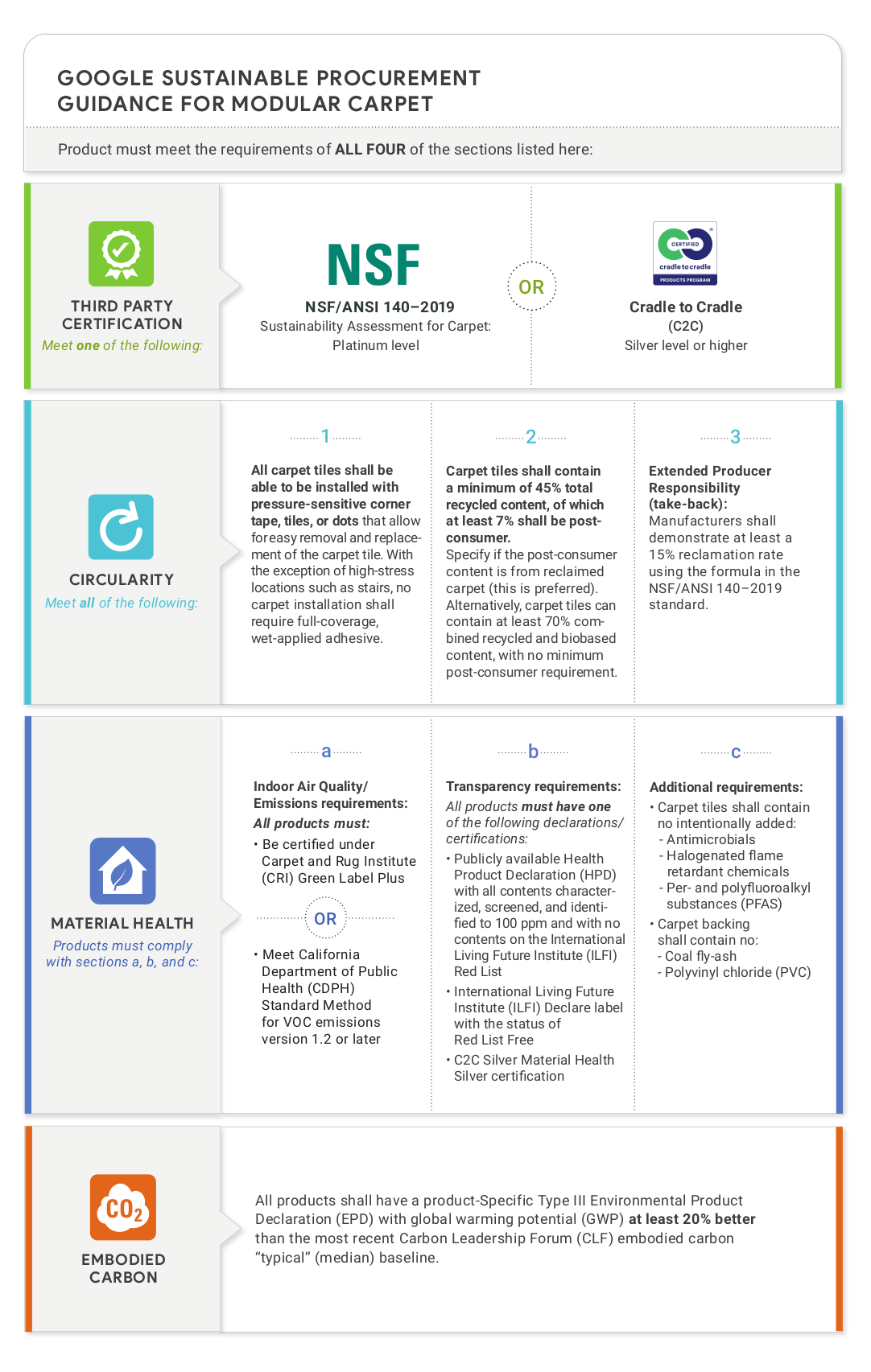Blog Post
Google Goes Public with Ambitious Carpet Tile Standard
Google sustainable procurement guidance for modular carpet, published with permission.
Newly released sustainability requirements for Google’s carpet tile procurement program aim to do just that. Google’s Real Estate and Workplace Services (REWS) organization has a long history of seeking out healthier materials, with both internal screening programs and robust support for industry standards like the Health Product Declaration (HPD). Separately, the company has pursued climate goals, investing in renewable energy generation and, more recently, committing to the ambitious goal of 24/7 carbon-free energy. In addition, Google has been exploring circular economy solutions. As consultants to the REWS Sustainability Team, BuildingGreen helped to develop criteria for carpet tile that tie together all these initiatives and support efforts by major manufacturers to invest in their most sustainable solutions.
“From my ten-year experience with procurement, it’s actually not a very common thing to include sustainability at the beginning of the process,” said Lily Han, who led that purchasing program within the Google Procurement Organization. Han worked closely with Robin Bass, sustainability programs team lead in REWS, to establish the requirements and then vet them with suppliers who could also meet Google’s needs in terms of quality, design options, price, and volume of production. The ultimate result was pre-qualification of several products from six manufacturers—at a pre-negotiated price.
Modeling the change we seek
The requirements, which you can download here, send a market signal to carpet manufacturers that could advance sustainability throughout the industry. “We have a longstanding program around transparency in the marketplace,” Bass said. That program is now complemented by initiatives aligned with “public commitments that we’ve made on carbon and circularity as well as water, and the timeline attached to those commitments.” To support those goals, “we should be asking for best in class.”
In addition to third-party certification focused on overall lifecycle impacts, such as Cradle to Cradle Silver or NSF 140 Platinum, the requirements also address various aspects of toxicity, embodied carbon, and circularity. By sharing these requirements, Google seeks not only to procure the most sustainable options itself, but also to increase their availability to everyone. The major carpet manufacturers all have more sustainable options available or in development, but until customers ask for them, these options might not get enough internal support or investment to replace mainstream options. “What manufacturers want to do is give their consumers what they want,” Bass said. “And if the message is clear, they’ll move with us.”
SUPPORT INDEPENDENT SUSTAINABILITY REPORTING
BuildingGreen relies on our premium members, not on advertisers. Help make our work possible.
See membership options »Participating manufacturers and their compliant product types
All compliant products are made with high-recycled-content nylon 6 face fiber; nylon 6,6 is not available with sufficient recycled content.
- Bentley: AFFIXX hard back PVC Free backing, adhesive-free installation tile
- Interface: CQuestBio or CQuestBioX backing, Aquafil EcoNyl fiber
- Milliken: PVC-Free WellBAC Comfort Cushion and nylon 6 fiber, available in these patterns: Surface Study, Whale Song, Moraine Eco, Comfortable Concrete Eco, Coastline)
- Mohawk: EcoFlex-One backing
- Shaw: Ecoworx Platinum backing, Ecosolution Q100 nylon fiber
- Tarkett: ethos with Omnicoat Technology backing
Closing the loop
When it comes to circularity, it’s not just what’s in the product but how it is installed that matters. All the major manufacturers have installation options that are lighter-touch than the standard full-coverage peel-and-stick adhesive. These alternatives typically cost less, release fewer VOCs into the space, increase the reusability of the carpet tiles, and save hours of work scraping adhesive off the subfloor before the next installation. Flooring contractors tend to stick (so to speak) with what they’re most familiar with, however—so even when Google asks for an alternative approach, that option doesn’t always make it into the spec or onto the floor.
Manufacturers can help by promoting these options. In responding to these sustainability requirements, the manufacturers have committed to doing that. In one case they are even creating a new strategic communications initiative around the advantages of avoiding full-coverage adhesive.
Pushing the next envelope
“We want to signal really clearly to carpet manufacturers where the bar is today and where we’re moving toward,” Bass explained, saying that means “getting more and more circular, getting lower and lower carbon emissions, increasing the optimization for health, and getting toxins out of products.”
And the same ramp-up process could soon be used for another complicated product category—commercial furniture.
“Furniture is the next frontier for this work,” Bass said. “We buy so much furniture, and we know the manufacturers are ready for us to come with an RFP,” which Bass argues will push “sustainability deep and drive market change.”
And it won’t stop there. BuildingGreen’s products experts, Brent Ehrlich and Nadav Malin, supported in their work for Google by spec writer Anne Hicks Harney and LCA expert Greg Norris, are now working with Bass to develop a list of additional commodities that are purchased in large volumes and ripe for higher sustainability standards.
Published February 7, 2023 Permalink Citation
Malin, P. (2023, February 7). Google Goes Public with Ambitious Carpet Tile Standard. Retrieved from https://www.buildinggreen.com/blog/google-goes-public-ambitious-carpet-tile-standard



Add new comment
To post a comment, you need to register for a BuildingGreen Basic membership (free) or login to your existing profile.